Pogača– Slovenia’s Traditional Welcome Bread
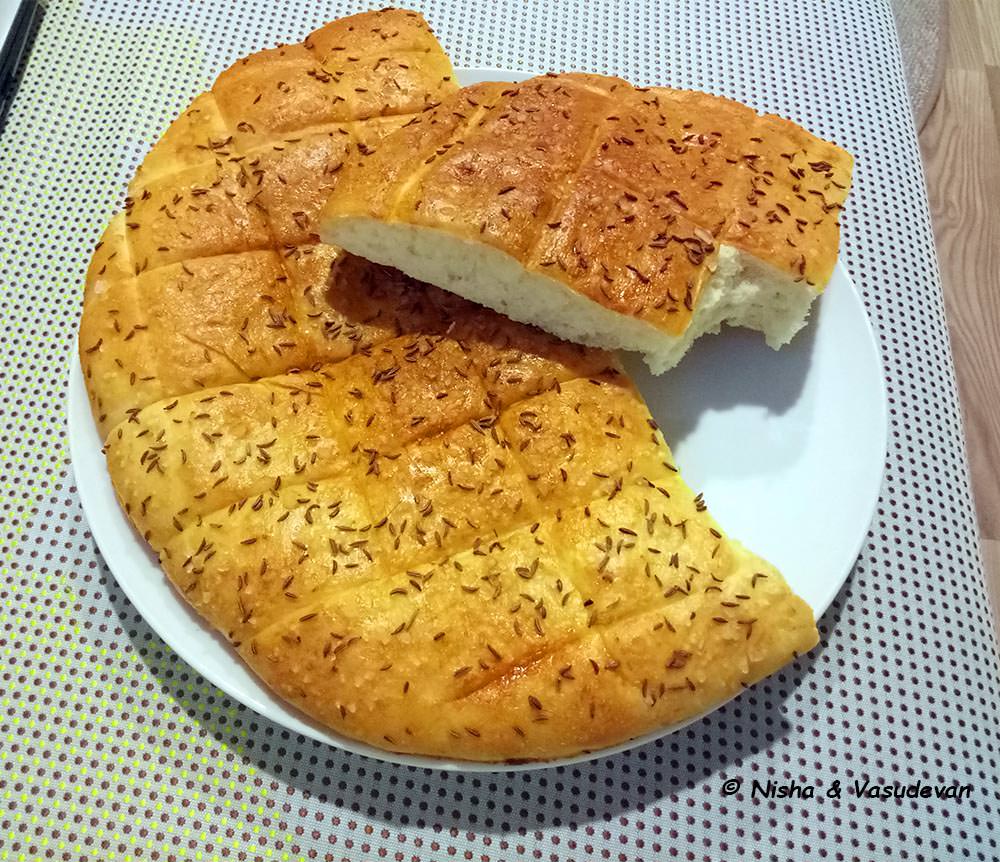
When I first saw Pogača, better known as Belokranjska Pogača Slovenia traditional bread, I wondered what was so unique about it. It looked similar to Slovakian, Hungarian, Russian or Turkish bread! And it’s a tradition in those countries also to welcome with a salted bread. I was wrong.
Baking Belokranjska Pogača, Slovenia traditional welcome bread, has been passed onto from generation to generation. Locally it is known as Belokranjska Pogača (pronounced as Pogacha) or Bela Krajina flat bread. Light, salty and round in shape Pogača is baked mostly to welcome guests at home.
There is a folk song that goes like this ‘Give him Pogača for a spring in his step’ when children go from house to house calling for Zeleni Jurij (Green George Festival).
Children would wait patiently when mothers prepared freshly baked Pogača but they were not allowed to eat till the guests had it. Hence Belokranjska Pogača was even more eagerly awaited! 😀
We were having it for breakfast every day! So I decided to join a workshop to learn.
How to make Pogača
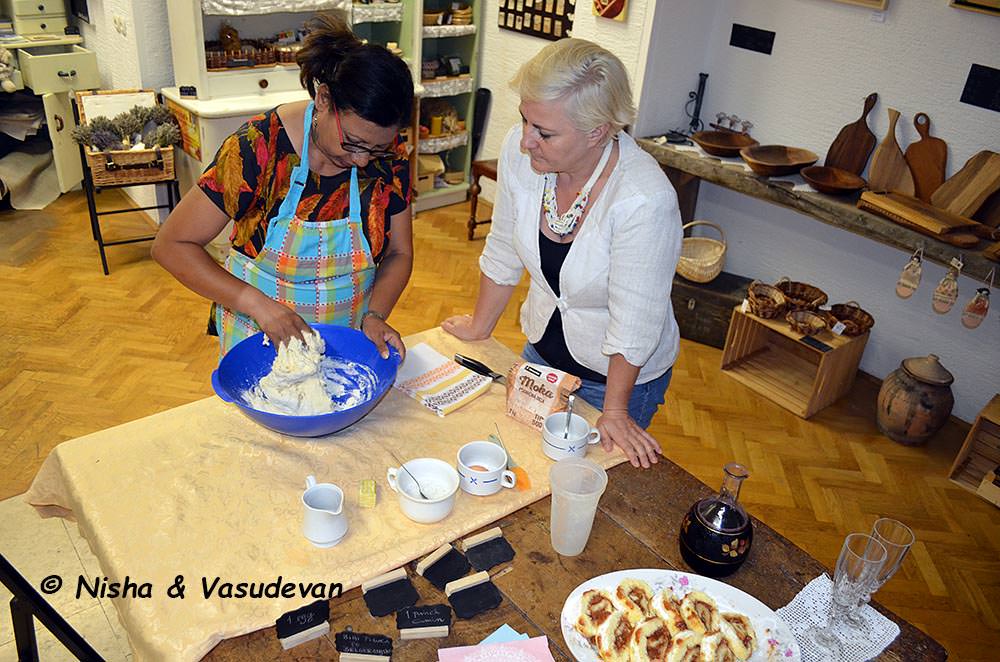
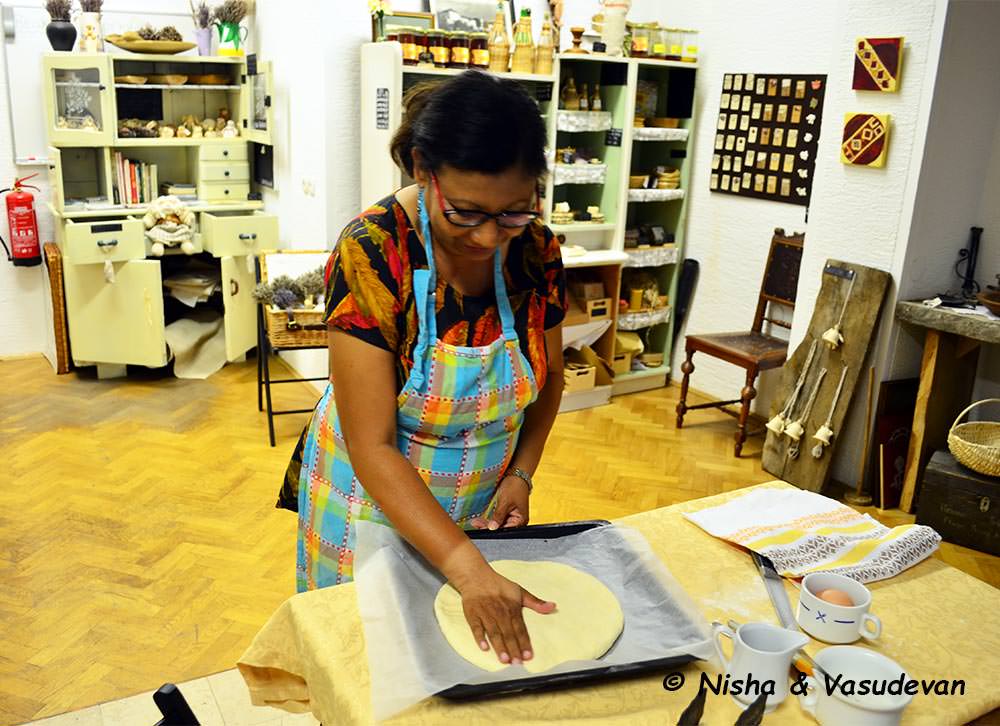
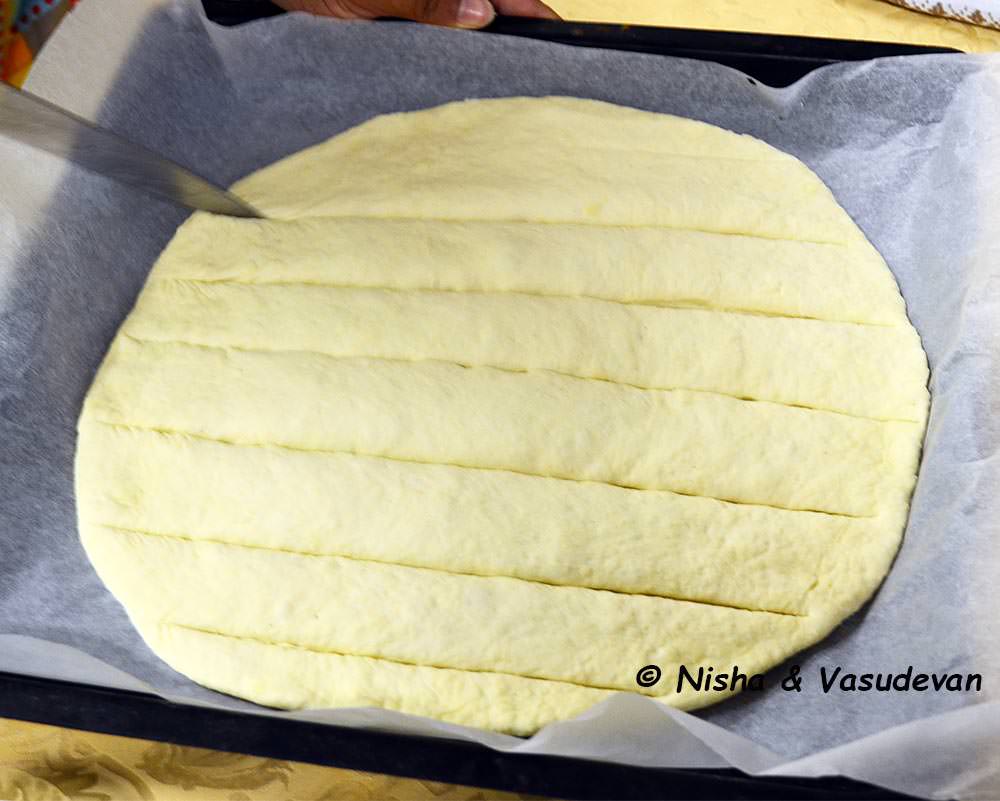
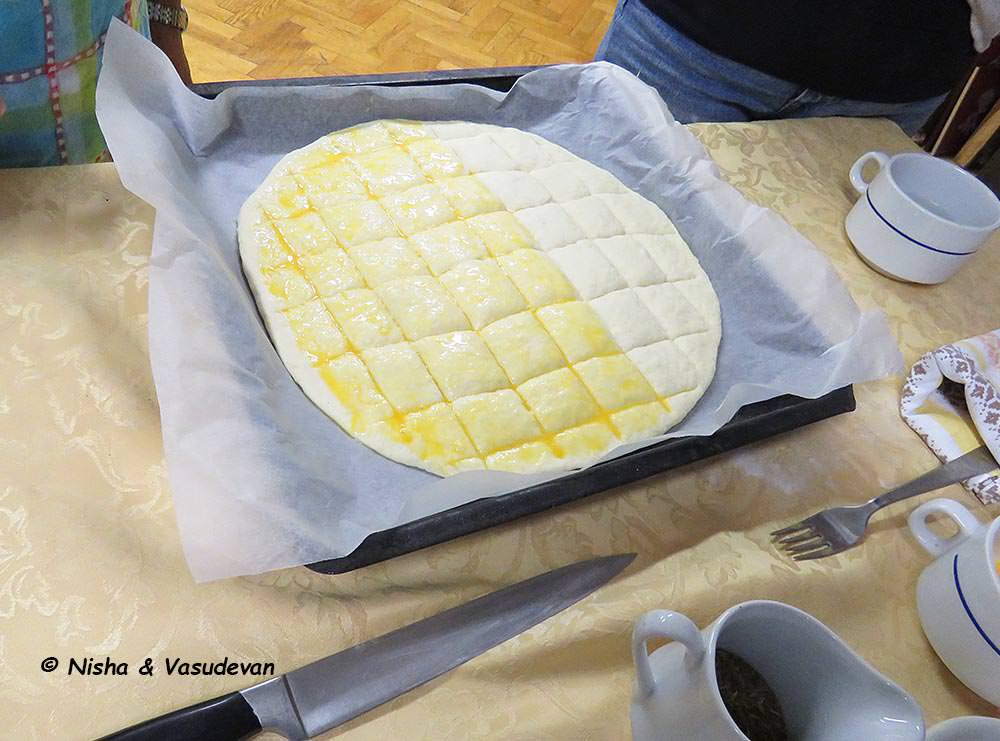
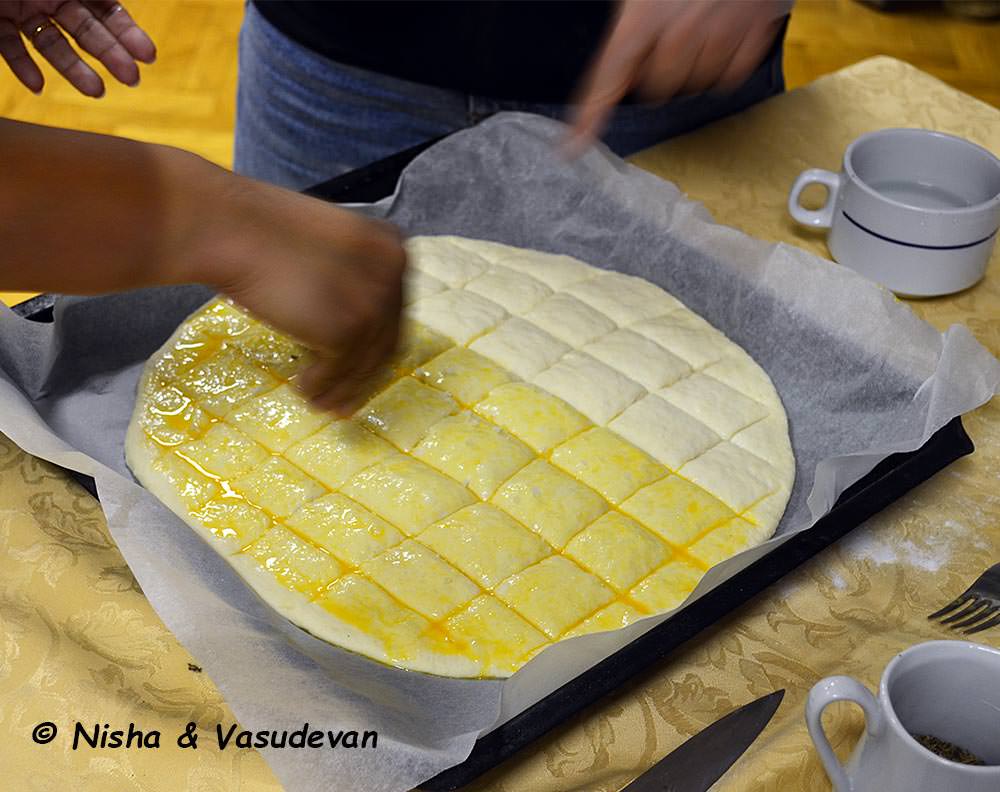

I started with pouring the measured flour into a large bowl and adding yeast (which I had soaked in water to activate it), a bit of sugar, salt, oil and warm water to it. Kneading was the next step and then she instructed me to fold the dough. My hands moved fast giving it the required suppleness and consistency. The best test for it is that the dough should not stick to your hands. The dough for Pogača was ready now and was left for 15-20 minutes to rise.
While waiting, Bernarda, the certified Pogača maker, told me all about Pogača.
Pogača (पोगाचा in Hindi) is a typical Slovenian welcome bread. Round in shape, it has a diameter of approximately 30 cm. The edges are 1–2 CMs thick while the centre is 3 to 4 cm thick.
Not everybody is allowed to make Pogača. To be able to make the standard Belokranjska Pogača, one has to pass an exam to prove one’s skills and get a certificate. The official size of a Pogača is 30 CMs. From time to time, the inspectors come to check if the Pogača makers are adhering to specifications or not.
Traditionally in Slovenia the guests are welcomed with a freshly baked Pogača and wine. Sometimes when the wine is ‘measured’ meaning it’s sold out, the homemade brandy or coffee is also offered to guests. The Pogača is not cut, instead the guests tear a piece off it, as a sign of being welcomed into the host’s house. The name, Pogača, has come from the Latin term panis focacius meaning ‘hearth, place for baking’. The roots of the flatbread take us back to the Slovenian region of Bela Krajina which is also known as White Carniola in English.
Now the dough was risen, double to its size; and I knew what to do with it. I made a flat round base, making sure that the centre was thicker than the edges. Barnarda’s watchful eyes were watching me and she was fine-tuning my techniques.
Next step was to make incisions with a knife on the base. Bernarda deftly showed me how to do it, total seven incisions … one in the centre and 3 on each side. I was careful to make the incision just deep enough so as not to cut the base into separate pieces. I then turned the based 90 degrees and made 7 more incisions. So now we had a lovely chequered design.
I coated the bread with a beaten egg, leaving a portion for those who do not eat eggs. Now it was almost ready to go into the preheated oven at 200-220 C. As per Bernarda’s instructions, I generously sprinkled some cumin seeds and coarse sea salt on it before its journey to the oven.
Twenty minutes later, the room was filled with the aroma of freshly baked Slovenian Pogača. Our sensory organs were accentuated and we were eager to bite into it. The grid on the surface made it easy to tear off pieces. Our Belokranjska Pogača Slovenia traditional welcome bread was welcoming us.

Party time!
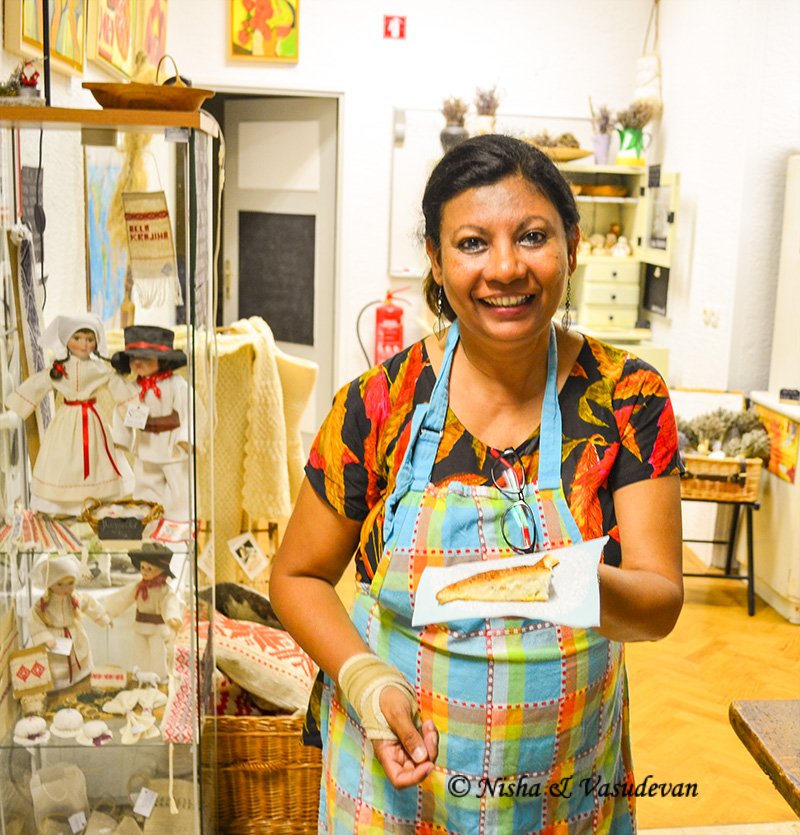
Soon, we were having a small party at Barnarda’s workshop cum showroom! The bread was soft and delicious. The crunchy salt crystals made it even better. We chatted with her over a glass of good quality wine Metliška črnina by K Z Metlika. Belokranjska Pogača was mostly baked in wine growing regions. It goes well with wine and in earlier days, people believed that Pogača soaked up the wine and prevented hangovers.
Barnarda has a showroom where she has displayed all the handicraft items which she procures from producers and sells. Among all the handicraft items my favourite was the embroidery work and painted eggs! I even tried my hands on an egg. It needs days of practice to be able to make some designs.
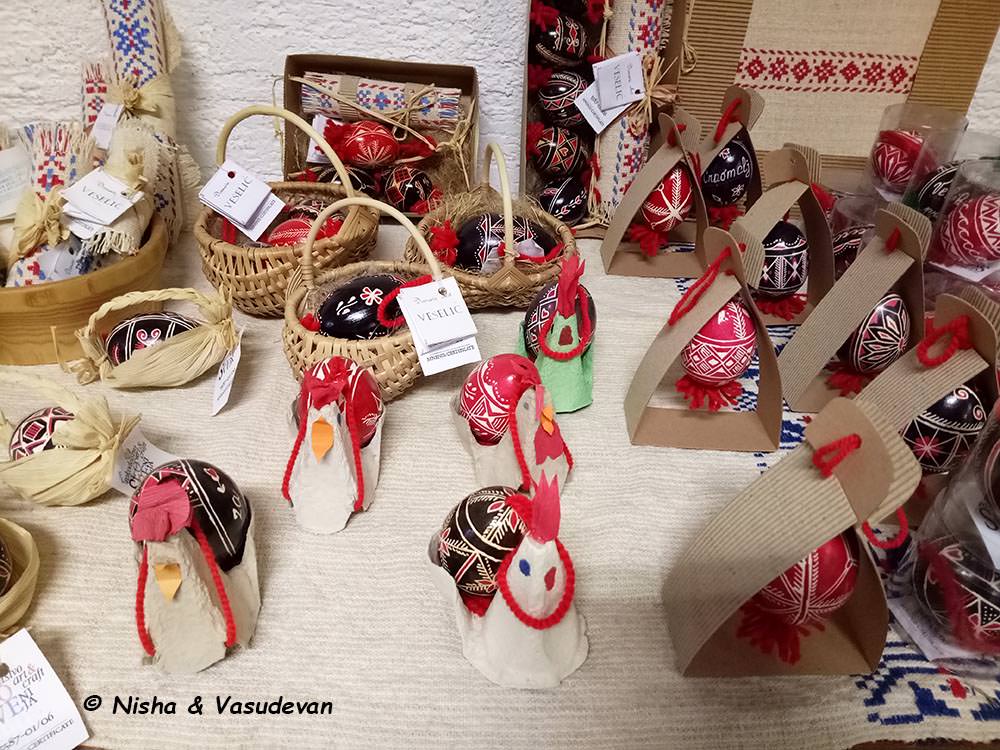
If you happen to visit Bela Krajina, Slovenia, make sure you try Belokrajnska Pogača. You can contact Bernarda Kump at BIBI Turizem and on Facebook.
Note: While what I made was the standard Belokranjska Pogača, the locals frequently bake with a lot of bacon or cheese toppings too. While this is not a standard Pogača, it is also quite delicious for those who love meat or cheese.
Getting there: Bela Krajina is a small traditional region in south-eastern Slovenia touching the Croatian border. It is at 100 KMs from Ljublijana and an hours’ drive from Croatian capital Zagreb.

Have you been to Slovenia before? What was the best food you tasted there? Share your experiences in the ‘Comments’ section below.
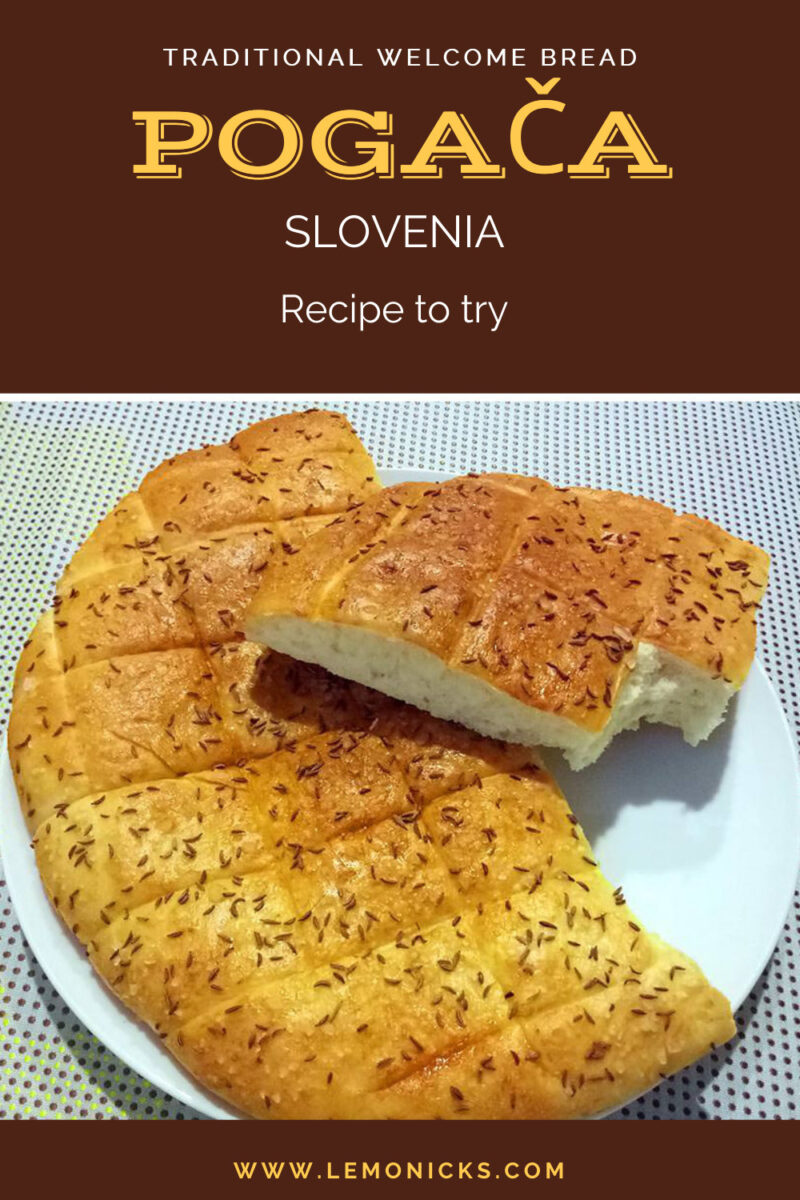
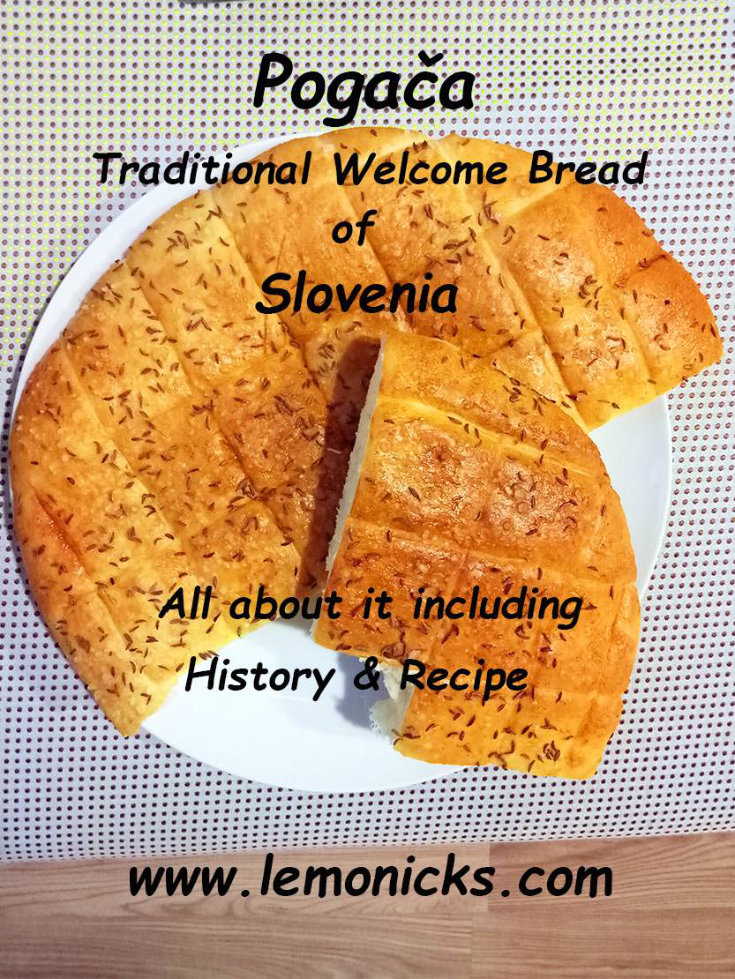

Splendid post. Loved going through this cultural delight of Slovenia.
Thank you Shubham.
Loved to read about Pogača 🙂 Nice post.
Thank you Rupam.
Glad to know about Pogaca and something about Slovenia!
I was somehow reminded of zatar bread of U.A.E…! 🙂
Even I wondered what was so unique about Pogača but after listening to stories and tasting it, I knew. 🙂
बहुत बढ़िया ब्लॉग. पगाचा देख कर ही दिल खुश हो गया !
Thank you. Khaake bhi dil khush ho jayega. 😀
wow !!! its an amazing, knew nothing about Pogaca, thanks for sharing.
You are welcome. 🙂
Now I am embarrassed, just realised as a native Slovenian, I never ate this pogaca. 🙂 Did you try potica?
Aww, how could it be possible that you never had Pogaca?
Yes, we had Potica and some other Slovenian dishes also. 😀
Wow! That is crazy that not everyone can make pogaca! It’s almost like not everyone can make sushi in Japan! It’s amazing how they are strict about it! It’s also exciting that you were able to participate in such a workshop! I should do a cooking workshop next time I travel!
Yes, they are very particular with specifications to protect the quality.
Sure, pls join a workshop. I am sure you’d love it.
This looks so good! I love the salt crystals and think they add so much flavor!
So interesting that not everyone can make this unless they are certified.
Yes, salt crystals were chunks that gave the bread another dimension. 😀
Yup, that’s the key of quality product.
It was fascinating to read about the Pogaca, especially loved the lyrics of the song associated with it. I was also taken on a trip down memory lane when I read that the kids had to wait patiently when the bread was being made for the guests. It reminded me of my own childhood days when mom was preparing sweets for guests 🙂
This looks so yummy! I wish I can make bread from scratch. It’s such a useful skill to have. I was surprised to read that not everybody is allowed to make Pogaca. I can see that requiring a certification for the breadmaker is a great way to keep the authenticity of the bread 🙂
When you say salty, how salty was it exactly? Just curious. It looks very tasty. How great that you got to learn how to make it. Is it normally made for guests from out of town, or for friends coming over for a chat too?
I’m a huge advocate of culinary tourism…. I mean, who doesn’t travel for food? But this is a great write-up of your cooking experiences abroad! I love how you interspersed the history of pogaca with the cooking process. When I was in the Balkans, I found out that they do love their bread! And it’s always some sort of round bread. Now I’m hungry!
What a great opportunity to cook Pogača while in Slovenia! Really interesting that not everyone is allowed to make it – obviously goes to how seriously they take their culinary heritage! I like that it’s traditionally not cut up – guests tearing pieces off feels like a more intimate meal with your group.
The bread looks delicious – can’t wait to get to Slovenia!
As the saying goes – teach a man how to bake a bread and he shall never go hungry again.
Well that seems like a literal statement when it comes to Pogaca.
Traversing through food in a country is the ultimate travel experience. I would love to visit Slovenia and check it out for myself as soon as possible.
it looks super yummy.. i will try this recipe and we will serve it for guest too with tea or coffee.
thanks for this yummy dish
This is something definitely unique that I’ve come across. I didn’t know that such traditional welcome does exist. Loved how you’ve written the basic recipe.. And what not everyone is allowed & one needs to have a certificate for the same? This break definitely means a lot to the Slovenians.. Also thanks for writing the pronunciation in devangiri makes it easier to read for us Indians! Hope to visit this place soon
Oh gosh that looks utterly divine. I love the way the ingredients are all showing on the little signs too. I am not really interested in cooking but I like the thought of eating it.
I’m hoping to go to Slovenia in March and I love the local food of a country so will be sure to look out for this bread. I like the sound of it topped with bacon and cheese too – yum!
I did a road trip through Slovenia this year and I so much of this bread that I must have gained at least 10 pounds! Slovenia is amazing and has it all! Nature, kind people and delicious food.
We went to so many countries in Europe and Slovenia won our hearts hands down!
And we have been recommending it to all. 😀
wow… I love civilizations that have traditional welcome breads… although baking or cooking was never my forte so hope someday will visit you for this…he he…
This for some reasons reminded my of King Ottokar’s Sceptre, where similar breads are depicted in various panels… Since Herge modeled Syldavia after Balkan states, I think it was pretty accurate…
This bread was similar to Hungarian or Russian bread, so I thought. But this one is very simple and a bit different. 🙂
wow ! I love cooking and this looks super easy to make. I’ll definitely try this at home.
And share it to my guests. I loved how you said children were not allowed to touch till guests had it. I remembered my childhood. 😀
Yes, it is easy to make and you don’t have restriction to get a certificate to make it. 🙂
Ha Ha I think all of us had that experience. 😀
Slovenia was a country that we really loved exploring so I loved reading the fascinating backstory you have shared here on pogaca. We enjoy cooking up authentic dishes from the countries we visit, so I will definitely be whipping up your pogaca recipe for a little culinary flashback
Sure! And wait for our other stories on the country ! Slovenia is beautiful to the core.
Wow, this post made my mouth water! I love the sound of Pogaca – and I love even more that you need to pass an exam and get a certificate to make it! I love your photos too – they really transported me there.
Ha Ha I loved calling Pogaca, Pogaca ! Sometimes Pagoca like a little girl making mistakes. 😛
Passing certificate is the first time I heard about for a dish commonly made at home.
That looks so good! Reading this made me hungry. And it’s interesting how you have to pass an exam to be able to make Pogača. I hope to get to try it one day.
Thank you. Sitting here in my home, I have started missing it.
Yes, I liked the idea of getting certified before you can make it.
This bread was my favourie food in Slovenia. I went glamping in Slovenia and every morning they would leave pogaca for breakfast along with some lovely spreads. It’s so interesting that not everyone is allowed to make pogaca! Such an interesting process!
I too loved it. The softness and the crunchiness of rock salt stole my heart.
What a coincidence! We also did glamping! 😀
I have never heard about Pogacha and the these are the ideal travel posts where people, food and culture gets combined into reflecting a society. Great one Nisha.
Thank you Anindya!
We both love to have the local food whenever we are on the road, so it was only apt to learn this simple bread and the stories related to it. 🙂
Pogacha sounds incredible! The combo of cumin and salt sounds like it made for a flavorful welcome treat! I too have done pysanky (the eggs). My friend is a Unkrainian-American artist who makes them for a living and she’s so talented. Like you said, it takes loads of practice! I hope to have a similar welcome to Slovenia when I make it there!
Yes, the combination did the trick and the bread is so fresh, aromatic that one can’t stop at one piece! 🙂
Egg thing is really hard work and practice.
Let me know how you were welcomed in Slovenia. 😉
This is so interesting Nisha…especially the fact that you did a class to learn making it after eating it everyday. I am in Nepal these days and very tempted to join in a class like that as well…
That reminds me that we need to meet in Mumbai…or maybe I can come over if you promise to welcome me with this bread 🙂
It was fun learning it Sid! 🙂
Ha Ha yes, we must meet but you are never in town! 😛
I love the instructions and pictures but I’m a shocking cook. Have no patience or interest in making stuff, but I quite like eating it.
Oooh this bread looks soooo good. Love learning how they make it and find it so interesting that only people who pass the exam can make the standard Belokranjska Pogača. Hope to visit one day and try the bread.
It’s so cool that you learned how to do it. In Romania, we have kind of a similar tradition when someone visits the country for the first time. Yup, I have been in Slovenia but for less than 24 h, and I visited the beautiful Lake Bled. I would love to go back and explore more 🙂
Now that is interesting. From the ingredients one cannot really make out that this is a special bread. It looks pretty ordinary but from what you mention in the post, it is obvious that it is quite sacred to the place. Imagine having to pass an exam for it. I don’t think we have anything like that in India
Ah, you wonder how innovative and creative humans can be using the same everyday ingredients with a bit of change in ingredients or a small change in cooking method. That grid on the baked bread looks lovely & yes, tempting to eat.
Great post, Nisha. From the first look, even I thought this is just a normal bread but it is not. Loved the tradition and song associated with Pogaca. It seems to hold high significance in Slovenia and imagine you need to pass a test to make Belokranjska Pogaca.
You explained the baking process so well and it looks quite tempting. Great pictures.
I spent some time in Slovenia’s Ljubljana, Lake Bled & Postojna I love the people, the country and the food. I wished I tried making the bread like you did. I would of love this…it interesting that you need to pass an exam to officially make this bread. Where did you attend this workshop. I will be back in Slovenia again and I would love to do this..
Wow the bread looks amazing and I’m so happy to see that yoh learned to bake it yourself! I’m not much into baking or cooking but I love trying local foods. Unfortunately it doesn’t seem like I came across this particular bread when I was in slovenia, it would’ve gone really well with wine.
This bread looked delicious all on its own, but when you mentioned bacon and cheese….. count me in! Cooking is such a great way to learn about a culture and a country, as it is quite literally breaking bread with your hosts.
I have just cooked my first Belokranjska pogača as it has been chosen by the Women of Slovenia for the Women’s day of Prayer on 2nd March 2019. My loaf needs to be a bit thinner and I really appreciated the instructions about making the cuts in the loaf. It looks fairly similar but the next one should look even better. Thank you. The background information also makes it clear why it has been chosen to offer to people after the service.